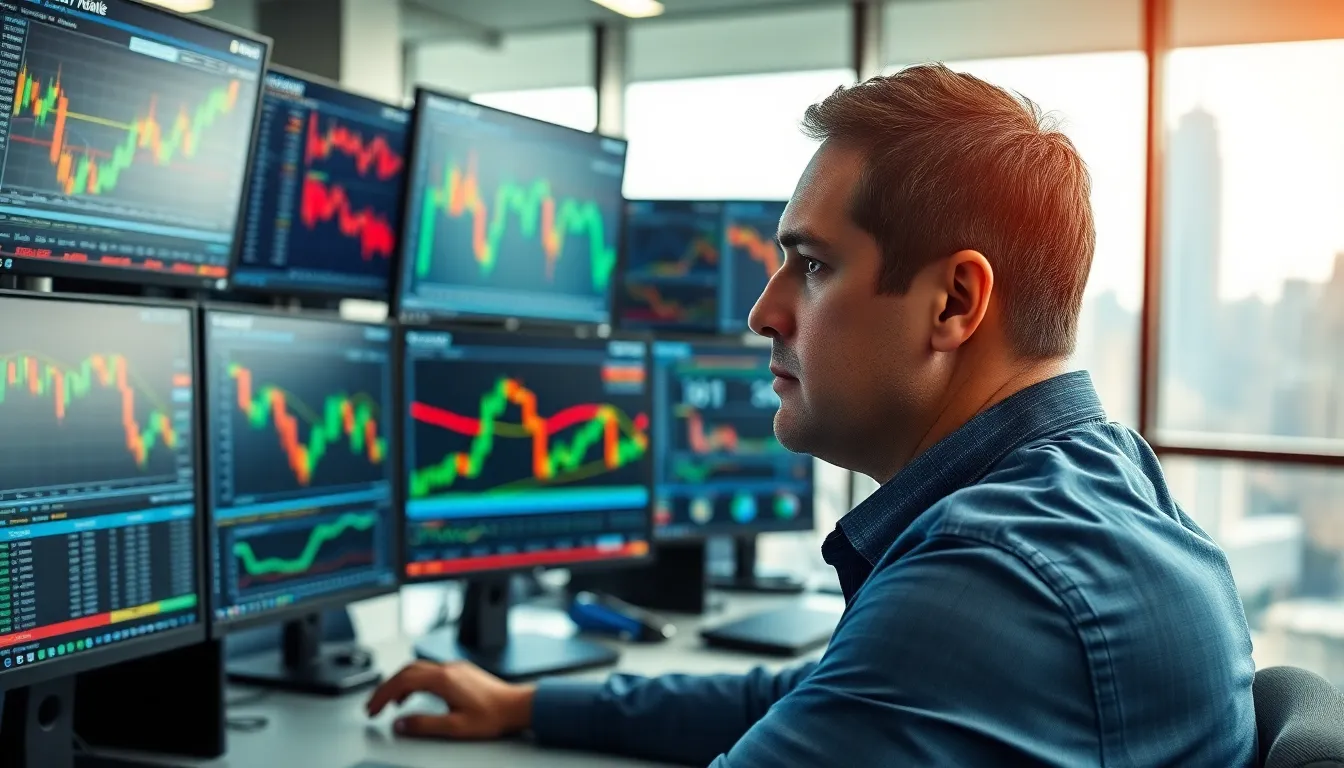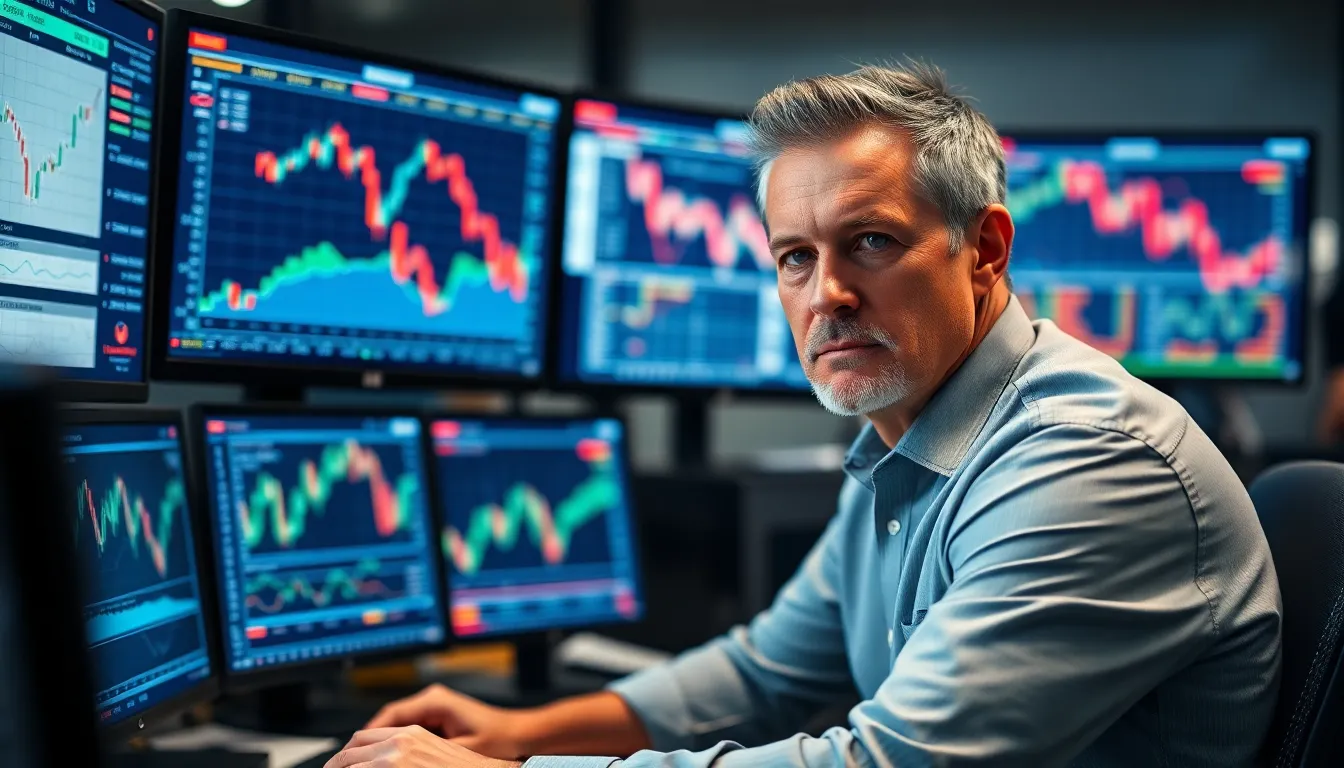Table of Contents
ToggleIn a world where time is money and the stock market never sleeps, automation in trading is the superhero investors didn’t know they needed. Imagine a tireless robot that analyzes market trends while you sip coffee or binge-watch your favorite show. Sounds dreamy, right? With automation, traders can harness powerful algorithms to make split-second decisions, leaving the guesswork behind.
Gone are the days of sleepless nights spent poring over charts and graphs. Automation takes the wheel, allowing investors to focus on strategy rather than stress. Whether it’s high-frequency trading or simply setting up alerts for market movements, this tech-driven approach is transforming the trading landscape. So grab your popcorn and get ready to dive into the world of automated trading—where profits can soar while you kick back and relax.
Overview of Automation in Trading
Automation in trading involves the use of technology to conduct trades without human intervention. Advanced algorithms analyze vast amounts of market data, identifying patterns and making trading decisions in real-time. This efficiency allows for rapid responses to market changes that manual trading cannot achieve.
Automated trading systems cater to various strategies, including high-frequency trading and algorithmic trading. High-frequency trading focuses on executing numerous orders at very high speeds. In contrast, algorithmic trading implements predefined rules based on market indicators.
Market participants leverage automated tools to minimize emotion-driven decisions. Traders can program parameters that align with their risk tolerance and investment objectives. Setting alerts for market movements enhances decision-making while individuals pursue other interests.
Reduced transaction costs represent a significant benefit of automation. By enabling continuous trading, automated systems often produce better entry and exit points. The potential for enhanced profitability attracts many investors to this approach.
Diverse platforms and software solutions offer automated trading capabilities. Popular platforms include MetaTrader, TradeStation, and ThinkorSwim, each providing various features to suit different trading styles. Users must evaluate their needs when selecting a platform to ensure it aligns with their trading strategies.
Factors like market volatility and liquidity influence the success of automated trading. An understanding of these elements helps traders optimize their systems. Continuous monitoring and adjustment of algorithms ensure they adapt to changing market conditions.
Automation in trading significantly reshapes the investment landscape, simplifying processes and enhancing profitability for traders.
Benefits of Automation in Trading
Automation in trading provides various advantages that enhance the trading experience and results. Efficiency increases substantially as technology handles trades, allowing for quicker execution and analysis of vast data sets.
Increased Efficiency
Efficiency benefits traders significantly through automation. Algorithms execute trades within milliseconds, which manual trading cannot match. High-frequency trading strategies exemplify this, processing thousands of orders per second. Automated systems monitor multiple markets simultaneously, capturing opportunities that human traders might miss. Furthermore, automation reduces the time spent on monitoring trades and analyzing charts, allowing traders to focus on forming strategies. Improved efficiency not only streamlines trading processes but also leads to greater overall profitability.
Eliminating Emotional Bias
Emotional bias can negatively impact trading decisions, leading to suboptimal outcomes. Automation minimizes this risk by following predefined rules objectively. Traders establish parameters based on their risk preferences, ensuring consistent execution regardless of market fluctuations. Removing human emotions helps in adhering to strategies during volatile conditions. In fact, automated systems execute trades without fear or greed influencing choices. This objectivity fosters discipline in trading practices and supports ongoing success. By leveraging automation, traders bolster their potential for more consistent returns.
Types of Trading Automation
Trading automation encompasses various methods, catering to different trading strategies and investor preferences. This section delves into two prominent types: algorithmic trading and high-frequency trading.
Algorithmic Trading
Algorithmic trading utilizes predefined algorithms to execute trades based on specific market signals. Investors build these algorithms to follow structured rules, which can include parameters such as price movement, average volume, and volatility. Various platforms support this strategy, allowing for customizable settings that align with individual risk tolerance and objectives. Additionally, algorithms can analyze vast datasets quickly, identifying trading opportunities that may not be immediately obvious. Enhanced efficiency leads to more timely decisions, increasing overall profitability. Successful implementation also requires ongoing adjustments to adapt systems to changing market conditions, ensuring relevance and effectiveness.
High-Frequency Trading
High-frequency trading emphasizes speed, executing numerous trades in fractions of a second. It leverages advanced technology and powerful algorithms to capitalize on small price discrepancies in the market. This strategy typically involves holding positions for very short durations, often just milliseconds or seconds, emphasizing rapid entry and exit. Traders participating in high-frequency strategies must employ sophisticated infrastructure to manage the execution of thousands of orders instantly. As a result, this method can yield significant returns, provided it operates within a highly liquid market. Continuous performance monitoring and algorithm refinement play key roles in maintaining a competitive edge in this fast-paced trading environment.
Challenges of Automation in Trading
Automation in trading offers many advantages, yet it also presents significant challenges. Understanding these challenges is crucial for successful implementation.
Technical Risks
Technical risks threaten the reliability of automated trading systems. System failures can occur due to software bugs, hardware malfunctions, or network issues. Furthermore, the reliance on technology exposes traders to cybersecurity threats, which may lead to data breaches and financial losses. Regular testing and updates of the software help mitigate these risks. Additionally, unexpected market conditions might cause algorithms to react inadequately, resulting in financial setbacks. Traders must remain vigilant and ready to intervene manually if systems fail.
Market Volatility
Market volatility represents a substantial challenge for automated trading. Sudden price swings can disrupt algorithmic strategies, leading to unintended consequences. Algorithms designed for stable market conditions may struggle to adapt to rapid fluctuations. For instance, a system optimized for slow-moving trends might incur losses during high volatility. Continuous monitoring of market conditions is essential to ensure that strategies remain effective. Adjusting algorithms in response to shifting trends helps maintain profitability amid uncertainties. Moreover, real-time data analysis allows traders to respond swiftly to changing market dynamics.
Future Trends in Automation in Trading
Emerging technologies are set to shape the future of automation in trading. Artificial intelligence (AI) and machine learning (ML) are leading the charge, allowing systems to learn from historical data and adapt strategies in real-time. These advancements enhance prediction accuracy, enabling more informed trading decisions.
Increased use of cloud computing offers traders greater scalability and flexibility. Cloud-based platforms facilitate efficient data processing and storage, allowing for seamless updates and system improvements. Consequently, traders can access their tools from anywhere, fostering greater collaboration and enhancing overall trading efficiency.
Integration of blockchain technology is also becoming important. This technology provides transparent, secure transactions, which can build trust among traders and reduce fraud risks. Additionally, smart contracts can automate trade settlements, streamlining processes and minimizing human errors.
Popularity of decentralized finance (DeFi) is on the rise. DeFi platforms can create decentralized automated trading systems, allowing users to trade directly without intermediaries. This trend could revolutionize how traders engage with the market, opening up new opportunities.
Data analytics continues to play a key role in automation. Sophisticated tools can analyze vast amounts of market data, identifying trends and patterns that inform trading strategies. With these insights, traders can optimize their approaches and improve performance.
Focus on regulatory compliance will remain crucial. As automation evolves, regulatory frameworks will adapt to ensure safe trading practices and protect investors. Automated systems must comply with new regulations to maintain market integrity and foster trust.
Overall, the landscape of automation in trading is shifting rapidly. Adopting new technologies and strategies is essential for success, as those who remain agile in their approaches will benefit from the innovative advantages this trend produces.
Conclusion
Automation in trading represents a significant evolution in how investors engage with the markets. By leveraging advanced algorithms and technologies, traders can navigate complex market dynamics with greater efficiency and reduced emotional bias. This shift not only enhances profitability but also allows individuals to reclaim valuable time for other pursuits.
As the landscape continues to evolve with innovations like AI and blockchain, staying informed and adaptable will be crucial. The future of trading automation promises exciting opportunities for those ready to embrace these advancements while remaining vigilant about the associated risks. Ultimately, automation is not just a tool; it’s a game-changer for modern investors.









